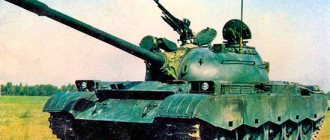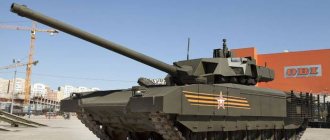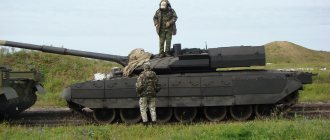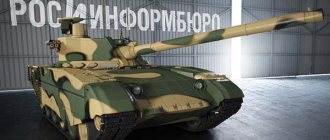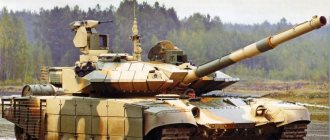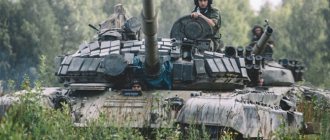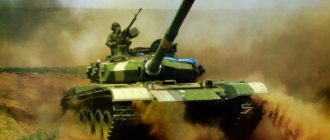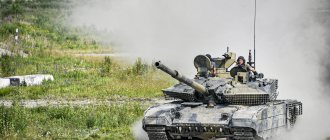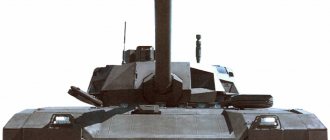Production of T-14 tanks. When and how much?
In 2015, the public was first shown the promising T-14 main tank, built on the unified Armata platform. Later, the first reports appeared about the launch of mass production of such equipment for one purpose or another. Industry is fulfilling received orders, and the military department is busy testing equipment. However, some features of the Armata program may seem like cause for concern. In addition, sometimes they try to make unhealthy sensations out of known facts.
MBT T-14
During production
By May 2015, NPK Uralvagonzavod had built several T-14 MBTs for testing.
These vehicles took part in the parade on Red Square and then returned to the testing site. It is likely that they were subsequently repeatedly shown in various reports, at exhibitions, etc. In the spring of 2016, news appeared in the domestic media about the purchase of 100 new tanks for military testing. At the beginning of September of the same year, the management of NPK UVZ clarified information about the production of equipment. Indeed, tank production has started, and the first vehicles have been delivered to the customer. In total, it was planned to build 2,300 tanks for our army. Such an order could take several years to complete. Such construction could be completed in 2022 or 2025, depending on various factors.
New information about the purchase of armored vehicles on the Armata platform appeared only in August 2022. As part of the Army-2018 forum, the Ministry of Defense entered into a contract for the purchase of an initial batch of 132 units of equipment. This number included T-14 MBT, T-15 heavy infantry fighting vehicles and T-16 repair and recovery vehicles. The first nine cars were supposed to go to the customer last year. Completion of the contract is scheduled for 2022.
At the very end of last year, it was announced that factory tests had been completed and state tests would soon begin. This stage of work was supposed to begin in 2022 and take some time. Based on its results, a decision was expected to be made on the future fate of the tanks and other equipment.
There have been no new reports of contracts for the production of the T-14 MBT. In addition, industry and the army are in no hurry to disclose details of the implementation of existing contracts. Apparently, the customer has already received a certain number of tanks and other armored vehicles on a unified platform. However, the new models have not yet been officially adopted for service.
Known examples
The exact number of T-14 tanks already built is unknown.
The same applies to other equipment on the Armata platform. However, the available data allows us to determine, at a minimum, a lower limit on the amount of finished equipment. In addition, the possible maximum number of tanks required is known. All this allows us to make assumptions and make estimates. It is known that by the time of the parade on Red Square, UVZ NPK had built at least 20 experimental MBTs and TBMPs. 10 tanks and 10 infantry fighting vehicles took part in the festivities and then returned for testing.
The status of a pilot batch of 100 vehicles, which was reported in 2016, still remains unclear. The lack of accurate information does not allow this batch to be classified as known and used in calculations.
Last year's contract provided for the supply of 132 armored vehicles, with 9 planned to be built before the beginning of 2022. According to known data, 44 units are planned for delivery this year. Thus, at least a dozen vehicles have already been completed under this contract, and approximately 120 will be built no later than 2022.
To date, we can speak with reasonable confidence about the production of at least 20 T-14 tanks. At least a hundred new machines are provided for under the existing and ongoing contract. New orders for hundreds of tanks and other armored vehicles may appear in the near future. However, before this, existing equipment must complete state tests and receive the necessary assessment.
It should be noted that the actual number of promising armored vehicles at test sites and in units may be significantly greater than what is known. The high priority of the Armata project leads to corresponding secrecy. Not all news about the release or testing of such equipment reaches the press and the public.
Plans and production
During discussions of the status and prospects of the T-14 MBT, they often recall statements of the past and compare them with the latest news.
Thus, in 2016, the management of Uralvagonzavod mentioned the need to build 2,300 tanks of a new type by 2020-25. At the same time, actual contracts provide for the delivery of more modest quantities - 132 vehicles by 2021. This discrepancy between statements and actions can be interpreted in different ways. Quite expectedly, they are trying to make an unhealthy sensation out of it. The discrepancy between numbers and deadlines is called a failure of the entire program, a threat to the country’s defense capability, a strategic miscalculation, etc.
At the same time, statements by officials about existing plans for the production of equipment are well known. They explain the current state of affairs and reveal expected events in the near future. There are also grounds for different plausible estimates. However, all official explanations and realistic assessments are unlikely to become a reason for high-profile publications.
Reasons for the lag
The main reason for the insufficiently high production rate of the T-14 can be considered the overall complexity of the project.
The Armata platform uses a number of new solutions for our industry that complicate the project. MBT based on such a platform is also quite complex. All new ideas need to be developed and refined, which requires time and money. The complexity of projects often leads to delays in work and the postponement of new stages. However, such problems usually find a solution and the project is completed with the desired results. The T-14 MBT, having new unusual components, could indeed require a longer development, and this is not surprising. In accordance with the change in the work schedule, the serial production dates have shifted.
In July last year, interesting features of the T-14 project were revealed by Deputy Prime Minister Yuri Borisov. He pointed out that the promising tank is more expensive than existing models that have undergone modernization. At the same time, the updated equipment meets current requirements in terms of characteristics.
TBMP T-15 - another model based on the Armata
If the T-72B3 tanks were inferior to foreign technology, the Ministry of Defense would begin full-scale construction of new T-14s. However, the current state of affairs allows us to take our time and calmly complete work on the Armata. Thus, the army will receive a new tank in the required quantities - but this will happen later, but the vehicle will be completely ready for service.
Previously, reports about the Armata included plans to build 2,300 tanks in the foreseeable future. Apparently, they were talking about the maximum required amount of equipment capable of ensuring the rearmament of the army. Based on the results of such serial construction, the ground forces could sharply reduce the share of old and modernized vehicles, and the new T-14s would become the basis of the tank fleet.
However, the urgent implementation of such plans was abandoned. The construction of the Armata MBT will not be accelerated, which will save money, and the defense capability will be supported by modernized tanks of old models. However, this approach does not exclude the construction of 2,300 tanks of the new model - but the last of them will enter the army later than originally planned.
Desires, opportunities, plans and adjustments
It is obvious that the Russian army needs a completely new tank that is not a reworking of an existing armored vehicle.
This type of technology has already been created and is even being produced in small series. Approximately in 2022, some parts of the army will begin trial military operation of the T-14 tanks ordered in 2018. The T-14 MBT is being created with an eye to the distant future. According to current estimates and plans, such equipment will be in use almost until the middle of the 21st century. As a result, it must not only meet modern requirements, but also have the potential for modernization in the future. Fulfilling such requirements is associated with known difficulties, and the work may be delayed. However, it is obvious that the T-14 main tanks will soon go into service and officially enter service. The only question is the exact date and the exact amount of equipment in each individual batch.
How the Armata project was disgraced
The delivery date for Armata tanks to the troops has once again been postponed. Now for 2022. But it was originally planned to begin mass production around 2015. As a result, the breakthrough project of an ultra-modern tank, instead of becoming a triumph for the Russian defense industry, showed the whole world its weaknesses.
Subject: Army
The concept of the tank included several advanced (at the time of creation) solutions. For example, an armored capsule for the crew, a “smart” suspension, remote-controlled weapons. But the main thing is the intellectual filling. In theory, the Armata could receive information from reconnaissance drones and radars and transmit target designation to the T-90 flight, coordinating its work. But the beautiful idea has not yet been realized. What went wrong?
Russia does not have the necessary technologies
Arms historians say that conceptually the Armata is not that new. It was preceded by the development of the T-74 and T-95 in the 1970s and 1990s, respectively. But they were never realized, because the capabilities of Soviet industry simply did not keep up with the ideas of military designers. First of all, we talked about electronics. But in the 21st century there is a real chance to make old dreams come true. But the point is not that the domestic defense industry has made a sharp leap in development. The opportunity simply arose to buy technology abroad, including from recent potential adversaries, NATO countries.
As a result, as far as we know, the most important components and assemblies were tied to foreign components. From the power plant to the sighting system. Even the armor used on the demos was made using foreign technology. But after the sanctions introduced against the Russian Federation in 2014, some Western developments turned out to be unavailable. We had to invest time in creating domestic analogues.
Plans collapsed after the ruble
Those imported components that can still be bought presented another surprise - an ever-increasing price. After all, the ruble exchange rate has been steadily declining in recent years. As a result, Uralvagonzavod simply could not name the final cost of serial production of the Armat. In 2015, it was about 250 million rubles, in 2018 – already about 450 million. The initial plan of the Ministry of Defense to purchase 2,300 new generation tanks, even at the first price, did not fit into reasonable budgets. And the appearance of a new price tag put negotiations on mass purchases on a long pause.
At the end of it, it was stated that there was no need to equip the Russian army with a large number of equipment such as Armata, since the latest versions of the T-72 tanks are highly effective. And this seemed reasonable given the fact that there are now more than 3 thousand T-80, T-90 and modernized T-72 tanks in service with the troops. In addition, from 10 to 15 thousand vehicles are mothballed at storage bases. It is not really clear why this armada should be replenished. After all, the scenario of the mass use of tanks to defend the borders of the Russian Federation looks quite fantastic.
Instead of workshops - unfinished construction
However, it is still necessary to develop and implement new technology to replace the old one in order to keep up with progress. And Western sanctions, as stated, contribute to the development of domestic industry. As a result, the Ministry of Defense and manufacturers agreed on a batch of “more than a hundred vehicles.” The sharp reduction in plans can be explained not only by the high price, but also by such an unpleasant story.
To assemble a new generation tank, Uralvagonzavod started building new workshops. The Moscow company received a tender for 756 million rubles in 2022, but in 2022 the company’s management was arrested. The managers were accused of stealing about 3 billion rubles received for the reconstruction of defense enterprises. Already before this, Uralvagonzavod had sued the general contractor over delays in the delivery of the facility and collected penalties, but in the end the workshops remained unfinished. So if in the very near future there was a need for mass production of Armata, the question would arise - where to make them?
By the way
Standard ammunition for the 2A82 smoothbore gun, which should be equipped with serial Armata combat vehicles, has not yet been presented. The contract for the development of the projectile was awarded to Rosatom. News about this appeared back in 2022, but there is no information about the results of development yet.
Andrey Terlikov promised at the IDEX 2022 exhibition in Abu Dhabi
, general designer of the machine developer, Ural Design Bureau of Transport Engineering.
Tank for parades and exhibitions
Uralvagonzavod does not give up and from time to time informs the public about the latest successes of its ever-promising product. For example, amenities such as a voice assistant are being developed for the crew. That is, the on-board diagnostic system of the Armata tank can independently determine the malfunction and report it in a pleasant female voice. The tank also has a full-fledged toilet so that the crew can carry out the combat mission for as long as possible.
While all these improvements were taking place, military experts began to say that the Armata concept itself was about to become obsolete. After all, now the focus is on unmanned military equipment. In accordance with this trend, in July last year, Armata was tested in unmanned mode. However, Rostec functionaries immediately stated: there is no talk of mass production of unmanned Armatas. It’s just that promising technologies are being tested on an experimental tank.
Meanwhile, last year the Armata received an export passport, and this year it was declassified at the IDEX 2021 international arms exhibition in Abu Dhabi. Even earlier, it was stated that a number of countries - China, India, Egypt and some states of Southeast Asia - expressed interest in purchasing the tank. However, it is difficult to say how this interest will be satisfied, because Uralvagonzavod has still not fulfilled the contract for the supply of hundreds of vehicles to the Russian Ministry of Defense, which was announced back in 2016. They are to be manufactured within the next one to two years. So far, the result of the Armata project is a test batch of two dozen vehicles. They have been undergoing tests for more than five years now, participating in parades and exhibitions.
Alexander Khramchikhin
Alexander Khramchikhin, Head of the Analytical Department, Institute of Political and Military Analysis
– The details of the implementation of the Armata project are kept secret, and it is quite difficult to judge its readiness today. Most likely there are some shortcomings, and it will still take some time to eliminate them. But still, the main reason for the delay is the unaffordable price of this tank. Apparently, the military and industry cannot agree with each other. It would be a shame if this became the reason for abandoning the Armata tank, as well as the whole family of vehicles created on its basis. In the Russian army, armored vehicles are hopelessly outdated and require updating. The design of the T-14 Armata tank is radically different from all modern Russian and foreign vehicles. The main innovation was the uninhabited tower, which gives the crew a greater chance of survival.
Tank roller: “Armata” is already in service, but “Breakthrough” is a priority
We drove and drove and finally arrived - the newest Russian T-14 tank, developed since 2009, on the Armata platform, was delivered to the troops not in the “ceremonial” version, but in the form of an industrial batch. It is not specified, however, in what quantity, but if you remember that the Ministry of Defense last year signed a contract for the supply of 100 such tanks, then there are definitely no more.
T-14 "Armata" is the latest development of domestic tank builders, ahead of its time, and can rightfully be considered the best tank in the world. It has a lot of features - an uninhabited turret, dynamic armor of the fourth generation, a unified tactical link control system, a circular Doppler radar with a medium-range AFAR (active phased antenna array) and ultraviolet HD cameras for all-round surveillance. Well, and a lot of other advanced technologies that make this tank unique and... inaccessible. Including for the Russian Armed Forces.
Tank T-14 "Armata": awe, respect and envy of the West
Britain and the United States have been experiencing conflicting feelings for six years now. After the appearance of the T-14 Armata in 2015, it became clear that the Anglo-Saxons did not have such equipment. NATO strategists essentially overlooked the importance of armored forces. The omission is strategic.
“Armata” (T-14) is one of the projects of the early 21st century that Russia successfully implemented, as recognized in The National Interest. Work on the tank began in 2010, instead of the canceled Object 195 program (as the T-95 was called in the design documentation). All the developments on it were transferred to the new car. It turned out to be revolutionary: a deserted tower, layered defense and powerful weapons.
Just like its strike capabilities, the T-14's armor protection is just as important. And here too there is something to brag about. The vehicle has a low silhouette, making it difficult to detect and defeat. A crew of three is located in the front of the vehicle, in an armored capsule isolated from the ammunition.
Its multi-layer composite tank armor is capable of withstanding hits from any existing anti-tank ammunition. And the stern is protected by grilles against grenades and cumulative missiles. The problem of all tankers - limited visibility - was solved by the designers of the Armata in a high-tech way by placing wide-angle video cameras around the perimeter of the armor. With their help, the crew sees everything that is happening around.
To control the battle, the commander and gunner have panoramic sights with a thermal imager and a laser rangefinder-target designator. Thanks to them, you can not only hit targets yourself, but also highlight them for other tanks, as well as aircraft and anti-tank missile systems. "Armata" is the world's first tank designed for network-centric warfare, when various combat systems interact in a digital network, exchange data and help each other.
The military usually pays little attention to comfort, but the designers of the T-14 also thought about it. There is even a toilet in the tank so that the crew does not have to leave the vehicle for physiological reasons.
But in the article further regarding the capabilities of the Western defense industry, there are only some reproaches to ourselves, complaints about a hard life, difficulties in bringing samples to the market, reproaches to the existing system, and so on. Not a clear paragraph about the prospects of our own similar developments. Why all this? Because Western partners, like no one else, know very well that the Armata tank really has maximum modern capabilities.
It is known that in the coming year a battalion of Armata tanks will enter the Russian troops. “Armata” is the most modern tank in the world, it is about 10-15 years ahead of all modern tank construction.
In general, go for it, gentlemen, if it works. In a couple of decades, it may be possible to catch up with this tank. During this time, Russian engineers will create a new one. “Let’s catch up and overtake Russia!” – the new eternal slogan of the American defense industry, it seems, may sound exactly like this.
Author Kirill Grishin, Sputnik radio
Short and to the point.
Only selected quotes in our Telegram channel.
Defense and attack
The Afghanit active protection complex provides protection for the T-14 from any existing ammunition. Anti-tank missiles are deflected from the tank by means of electronic warfare, heat-seeking missiles are confused by a smoke-metal curtain. In addition to the Afghanit, dynamic protection is used - reactive armor, with the help of which shells that break through closer to the tank are physically destroyed by detonating modules at a safe distance from the hull.
In addition, the T-14 used a revolutionary solution for the first time - an uninhabited turret. Thanks to this, the crew is housed separately in the tank hull in an armored capsule. The level of protection for tank crews is such that they are able to work even under conditions of a chemical or nuclear attack.
In terms of firepower, the Armata tank also surpasses all existing analogues. The 2A82-1M smoothbore 125mm main gun with a fully automated loading system can be controlled remotely. Different projectiles can be used for different purposes: cumulative, guided or high-explosive.
It is worth noting the stealth means used by the designers of the T-14. They reduce the visibility of the tank in the IR and radiomagnetic ranges. A special system mixes tank exhaust gases with cold air. And the body of the machine is thermally insulated from the inside and coated with special paint on the outside.
